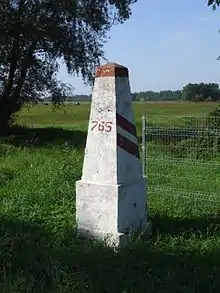Latvia–Lithuania border
The Latvia–Lithuania border is the state border between Latvia and Lithuania. The length of the land border is 588.1 kilometres (365.4 mi) with additional 22.2 kilometres (13.8 mi) of sea border.[1]

.jpg.webp)
.jpg.webp)
The border starts from the triple junction of the borders with Belarus to the north of Lake Drūkšiai (55°40′50.17″N 26°37′49.79″E)[2] and stretches to the coast of the Baltic Sea, where it ends between Palanga and Rucava. For 30 kilometres (19 mi) the border follows the Šventoji River.
History
The border started to exist after the Battle of Saule on 22 September 1236 and then was later solidified after the Battle of Durbe on 13 July 1260. There were some disputes on the exact location of the border but these were settled.
The border became partially defunct at incorporation into the Russian Empire and then later into the Soviet Union, since it became an internal state border. The international border was restored at independence in 1991. After prolonged negotiations, in July 1999, the border between territorial waters was drawn as a straight line between 56°04′08.9″N 21°03′51.47″E and 56°02′43.5″N 20°42′35.0″E.[3]
Border crossing
Between 1991 and 2007, there were border checkpoints between the countries, now abandoned,[4] after both nations joined the Schengen Area in December 2007,[5] allowing unrestricted border crossing.
References
- "Valstybinės sienos demarkavimas" (in Lithuanian). National Land Service under the Ministry of Agriculture. 2013-02-28. Retrieved 2015-10-04.
- "Lietuvos Respublikos Vyriausybės, Baltarusijos Respublikos Vyriausybės ir Latvijos Respublikos Vyriausybės susitarimo dėl valstybių sienų sankirtos taško paženklinimo tvarkos" (in Lithuanian). Seimas. 1998-03-25. Retrieved 2015-10-04.
- "Lietuvos Respublikos ir Latvijos Respublikos sutartis dėl teritorinės jūros, išskirtinės ekonominės zonos ir kontinentinio šelfo atribojimo Baltijos jūroje" (in Lithuanian). Seimas. 1999-07-09. Retrieved 2015-10-04.
- Check satellite images and Street View, at e.g. at 56.077356°N 21.122541°E and 56.274576°N 24.365519°E
- "Latvia joins Schengen Zone". www.mfa.gov.lv. Retrieved 17 August 2018.